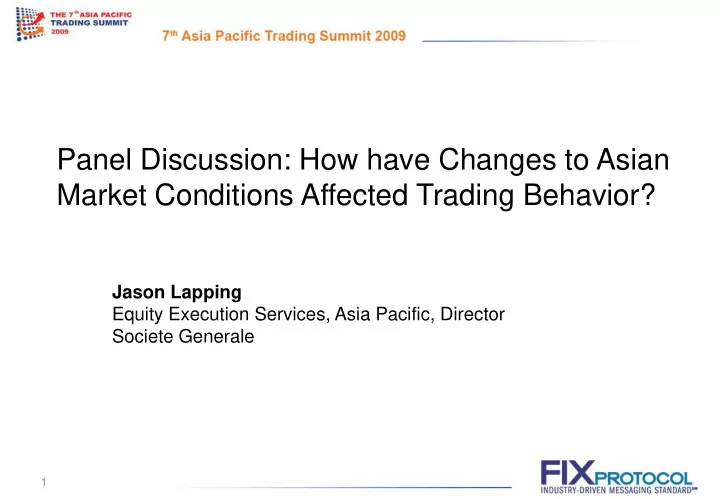

Panel Discussion: How have Changes to Asian Market Conditions Affected Trading Behavior? Jason Lapping Equity Execution Services, Asia Pacific, Director Societe Generale 1
Volatility Volatility Per Country's MSCI Index 120% Japan HongKong Australia 100% 91% Korea Taiwan Singapore 80% India Total 60% 40% 36% 20% 0% Jun-08 Jul-08 Aug-08 Sep-08 Oct-08 Nov-08 Dec-08 Jan-09 Feb-09 Mar-09 Apr-09 May-09 At the height of the crisis the violent daily price moves peaked in October, this can be quantified by looking at the Average Annualised 10 Day Historic Volatility which peaked in October at 91% ( 5.7% per day) up just under three times from 36% (equivalent to a 2.2% move per day) pre-crisis in June. Correlation has increased between all markets showing similar levels of volatility in Emerging and Developed markets alike are clustered around the 48% level. 2
Liquidity Daily Traded Valuesin USD 50.0 45.0 Japan HongKong Australia Korea 40.0 Taiwan Singapore India 35.0 % Change in USD Value Traded Q1 '09 Q3 '08 USD (billions) 30.0 vs vs Q2 '09 Q2 '09 25.0 Total 43% -3% 20.0 Developed 26% -13% Emerging 96% 44% 15.0 Australia 22% -40% 10.0 Japan 11% -18% Hong Kong 70% 17% 5.0 India 89% 24% 0.0 Singapore 93% 30% Korea 81% 40% Jun-08 Jul-08 Aug-08 Sep-08 Oct-08 Nov-08 Dec-08 Jan-09 Feb-09 Mar-09 Apr-09 May-09 Taiwan 124% 66% Source : Bloomberg & Societe General Q2 has seen an increase of 43% nominal traded in Asia Pac but is still 3% lower than pre-crisis levels Volumes in Emerging Markets have seen a 96% increase in the value traded between Q1 and Q2 2009, now trading 44% more per day than pre-crisis. 3
Spreads Average Spread per MSCI Index Average Spread of MSCI Index per Market Ticks 0.45% 3.0 Japan Total HongKong 0.40% 2.8 Australia Japan Korea HongKong 0.35% 2.6 Taiwan Australia Singapore Korea India 2.4 0.30% Total Taiwan Singapore 2.2 0.25% 2.0 0.20% 1.8 0.15% 1.6 0.10% 1.4 0.05% 1.2 1.0 0.00% Oct-08 Nov-08 Dec-08 Jan-09 Feb-09 Mar-09 Apr-09 May-09 Jun-08 Jul-08 Aug-08 Sep-08 Oct-08 Nov-08 Dec-08 Jan-09 Feb-09 Mar-09 Apr-09 May-09 Spreads across the region were very quick to increase at the start of the crisis peaking in November at 23.3bps up 31% but have been slow in tighten. Spreads currently average 19.5bps up 10% from June 2008 when the averaged 17.8bps. The worst affected markets have been Singapore and Korea where spreads are still 33% and 9% higher but dropped sharply in May Market structure is still the key determining factor impacting market spreads with the average spread in Asia Pac being 1.6 ticks 4
Theoretical Impact Costs per Market Theoretical Impact Cost Model per Country vs Previous Close 0.80% Japan HongKong 0.75% Australia Korea 0.70% Taiwan Singapore 0.65% India 0.60% 0.55% 0.50% 0.45% 0.40% Aug-08 Sep-08 Oct-08 Nov-08 Dec-08 Jan-09 Feb-09 Mar-09 Apr-09 May-09 The chart shows the estimated cost to execute an order with a fixed nominal which in June 2008 represented 8% of ADV . The chart tracks the change in estimated Impact Cost versus the Previous Close to execute the same nominal order given the changed market conditions. Theoretical Impact Cost is a function of Volatility, Spread and Liquidity . The increases in Volatility & Spreads combined with lowered Liquidity saw Total Impact Cost more than 50% but is showing real signs of recovery and stability as Volatility and Spreads fall from their highs and liquidity returns. 5
Benchmark Selection Execution Strategies 100% 90% With Vol / % Nominal of Orders Executed Shotfall / Iceberg 80% / Snipe Average 70% 70% 60% 50% 53% VWAP / TWAP 40% Average 30% 20% 10% 0% Jun-08 Jul-08 Aug-08 Sep-08 Oct-08 Nov-08 Dec-08 Jan-09 Feb-09 Mar-09 Apr-09 The increased volatility of traded prices and unpredictability of liquidity has see the % of orders traded as VWAP drop from 70% to just over 53% as buy side traders look to minimise price uncertainty and get trades done more actively rather than spreading and order out over the day. 6
Recommend
More recommend